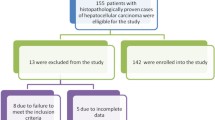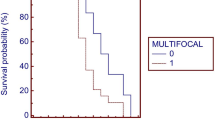Abstract
Purpose
Hepatocellular carcinoma (HCC) is the most common cancer in Mongolia. We aimed to investigate the clinical features, therapeutic modalities, overall survival and prognostic factors for Mongolian patients with HCC.
Method
One hundred ninety-five patients with HCC were consecutively enroled in our study.
Results
The mean age was 61.7 years. The most common etiology for HCC was HCV infection (n = 89, 45.6%), followed by HBV infection (n = 67, 34.4%). The mean tumor diameter was 6.0 ± 2.6 cm. Only 29 (14.9%) patients had a single lesion, while 39 (20.2%) had >3 lesions. Extrahepatic metastasis to lung (n = 23), bone (n = 10) and lymph node (n = 3) were detected in 36 (18.5%) patients. Most patients had advanced HCC—88 (45.1%) in stage III and 57 (29.2%) in stage IV. Surgical resection was performed in 27 (13.8%) patients, RFA in 23 (11.8%) and TACE in 107 (54.9%). When all the patients were categorized as ‘treated’ (n = 156) and ‘not treated’ (n = 39), the 3-year survival was significantly lower in the ‘not treated’ group than in the ‘treated’ group (11 vs. 0%, P < 0.001). Tumor diameter (<3 cm vs. ≥3 cm), extrahepatic metastasis, TNM stage (I/II vs. III/IV) and treatment (or supportive care) were selected as independent predictors for survival.
Conclusions
High proportion of patients with HCC in Mongolia is diagnosed at an advanced stage and survival of these patients is lower compared to other countries. A surveillance system and referral policy for high-risk groups should be urgently established and implemented in Mongolia.


Similar content being viewed by others
References
El-Serag HB. Hepatocellular carcinoma. An epidemiologic view. J Clin Gastroenterol 2002;35(suppl. 2):S72–S78
Parkin DM, Bray F, Ferlay J, et al. Global cancer statistics. 2002. Cancer J Clin 2005;55:74–108
El Serag HB, Mason AC. Rising incidence of hepatocellular carcinoma in the United States. N Engl J Med 1999;340:745–750
McGlynn KA, Tsao L, Hsing AW, et al. International trends and patterns of primary liver cancer. Int J Cancer 2001;94:290–296
Yoshizawa H. Hepatocellular carcinoma associated with hepatitis C virus infection in Japan: projection to other countries in the foreseeable future. Oncology 2002;62(suppl 1):8–17
Han K-H, Ahn SH. How to predict hepatocellular carcinoma development in patients with chronic B viral liver disease. Intervirology 2005;48:23–28
Ahn SH, Yuen L, Han KH, et al. Molecular and clinical characteristics of hepatitis B virus in Korea. J Med Virol 2010;82:1126–1134
Jung KS, Kim SU, Ahn SH, et al. Risk assessment of hepatitis B virus-related hepatocellular carcinoma development using liver stiffness measurement (Fibroscan). Hepatology 2011;53:885–894
Nymadawa P. Hepatitis B vaccination: worldwide and in Mongolia, 2004. In The 10th National Conference “Current Topics of Virology” (Abstracts), p. 115–116
Baatarkhuu O, Kim DY, Ahn SH, et al. Prevalence and genotype distribution of hepatitis C virus among apparently healthy individuals in Mongolia: a population-based nationwide study. Liver Int 2008;28:1389–1395
Health Indicators. National Health Development Center, Mongolia. ed.; 2004.
Parkin DM. The global health burden of infection-associated cancers in the year 2002. Int J Cancer 2006;118:3030–3044
Kim SU, Han KH, Nam CM, et al. Natural history of hepatitis B virus-related cirrhotic patients hospitalized to control ascites. J Gastroenterol Hepatol 2008;23:1722–1727
Kim Do Y, Kim SU, Ahn SH, et al. Usefulness of FibroScan for detection of early compensated liver cirrhosis in chronic hepatitis B. Dig Dis Sci 2009;54:1758–1763
Lee JM, Park JY, Kim Do Y, et al. Long-term adefovir dipivoxil monotherapy for up to 5 years in lamivudine-resistant chronic hepatitis B. Antivir Ther 2010;15:235–241
Bruix J, Sherman M, Llovet JM, et al. EASL panel of experts on HCC. Clinical management of hepatocellular carcinoma: conclusions of the Barcelona 2000 EASL conference. European Association for the Study of Liver. J Hepatol 2001;35:421–430
Liver Cancer Study Group of Japan. The general rules for the clinical and pathological study of primary liver cancer (English ed.) Kanehara & Co, Ltd: Tokyo; 2003
Borzio M, Colleredo G, Pioltelli P, et al. Epidemiology and outcome of hepatocellular carcinoma in Lombardy. Dig Liver Dis 2007;39:1011–1017
Markovic S, Gadzijev E, Stabuc B, et al. Treatment options in western hepatocellular carcinoma: a prospective study of 224 patients. J Hepatol 1998;29:650–659
Stroffolini T, Andreone P, Andriulli A, et al. Characteristics of hepatocellular carcinoma in Italy. J Hepatol 1998;29:944–952
Amarsanaa J, Baatarkhuu O, Chinburen J. Current situation of HCC in Mongolia. Mong J Oncol 2010;4:15–19
Kondo Y, Mizokami M, Nakano T, et al. Prevalence and molecular epidemiology of GB virus C/hepatitis G virus infection in Mongolia. J Med Virol 1997;52:143–148
Takahashi M, Nishizawa T, Gotanda Y, et al. High prevalence of antibodies to hepatitis A and E viruses and viremia of hepatitis B, C, and D viruses among apparently healthy populations in Mongolia. Clin Diagn Lab Immunol 2004;11:392–398
Tsatsralt-Od B, Takahashi M, Nishizawa T, et al. High prevalence of hepatitis B, C, and delta virus infections among blood donors in Mongolia. Arch Virol 2005;150:2513–2528
Oyunsuren Ts, Sanduijav R, Davaadorj D, et al. Hepatocellular carcinoma and its early detection by AFP testing in Mongolia. Asian Pac J Cancer Prev 2006;7:460–462
Raza SA, Clifford GM, Franceschi S. Worldwide variation in the relative importance of hepatitis B and hepatitis C viruses in hepatocellular carcinoma: a systematic review. Br J Cancer 2007;96:1127–1134
WHO and National Cancer Center of Mongolian Report. Sub-programme on cancer prevention and control Ulaanbaatar 2009
Sherman M. Surveillance for hepatocellular carcinoma and early diagnosis. Clin Liver Dis 2007;11:817–837
Tremosini S, Reig M, de Lope CR, et al. Treatment of early hepatocellular carcinoma: towards personalized therapy. Dig Liver Dis 2010;42(Suppl 3):S242–S248
Lencioni R. Loco-regional treatment of hepatocellular carcinoma in the era of molecular targeted therapies. Oncology 2010;78(Suppl 1):107–112
El-Serag HB, Kramer JR, Chen GJ, et al. Effectiveness of AFP and ultrasound tests on hepatocellular carcinoma mortality in HCV-infected patients in the USA. Gut 2011;60:992–997
Ahnmad K. Pakistan: a cirrhotic state? Lancet 2004;364:1843–1844
Acknowledgements
This study was supported partly by the Grant of the Korea Healthcare Technology R&D Project, Ministry of Health and Welfare, Republic of Korea (no. A102065) and partly by funds from Yonsei Liver Blood Bank (YLBB).
Author information
Authors and Affiliations
Corresponding author
Additional information
O. Baatarkhuu and D. Y. Kim equally contributed to this work.
Rights and permissions
About this article
Cite this article
Baatarkhuu, O., Kim, D.Y., Nymadawa, P. et al. Clinical features and prognosis of hepatocellular carcinoma in Mongolia: a multicentre study. Hepatol Int 6, 763–769 (2012). https://doi.org/10.1007/s12072-011-9325-4
Received:
Accepted:
Published:
Issue Date:
DOI: https://doi.org/10.1007/s12072-011-9325-4




